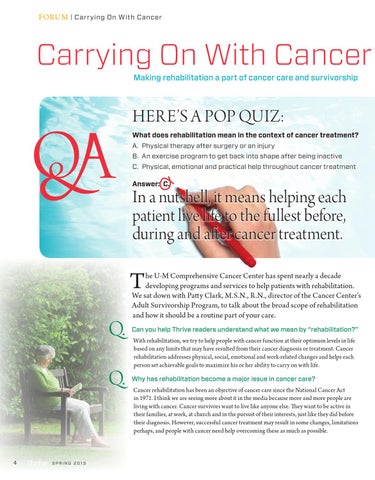FORUM | Carr ying On With Cancer
Carrying On With Cancer Making rehabilitation a part of cancer care and survivorship
HERE’S A POP QUIZ: What does rehabilitation mean in the context of cancer treatment? A. Physical therapy after surgery or an injury B. An exercise program to get back into shape after being inactive C. Physical, emotional and practical help throughout cancer treatment Answer: C.
In a nutshell, it means helping each patient live life to the fullest before, during and after cancer treatment.
T Q.
he U-M Comprehensive Cancer Center has spent nearly a decade developing programs and services to help patients with rehabilitation. We sat down with Patty Clark, M.S.N., R.N., director of the Cancer Center’s Adult Survivorship Program, to talk about the broad scope of rehabilitation and how it should be a routine part of your care.
Can you help Thrive readers understand what we mean by “rehabilitation?”
Q.
With rehabilitation, we try to help people with cancer function at their optimum levels in life based on any limits that may have resulted from their cancer diagnosis or treatment. Cancer rehabilitation addresses physical, social, emotional and work-related changes and helps each person set achievable goals to maximize his or her ability to carry on with life.
Why has rehabilitation become a major issue in cancer care?
4
SPRING 2013
Cancer rehabilitation has been an objective of cancer care since the National Cancer Act in 1971. I think we are seeing more about it in the media because more and more people are living with cancer. Cancer survivors want to live like anyone else. They want to be active in their families, at work, at church and in the pursuit of their interests, just like they did before their diagnosis. However, successful cancer treatment may result in some changes, limitations perhaps, and people with cancer need help overcoming these as much as possible.
